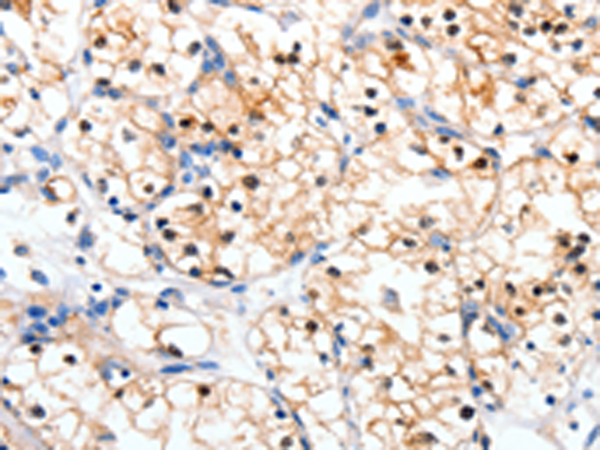


| WB | 咨询技术 | Human,Mouse,Rat |
| IF | 咨询技术 | Human,Mouse,Rat |
| IHC | 1/10-1/50 | Human,Mouse,Rat |
| ICC | 技术咨询 | Human,Mouse,Rat |
| FCM | 咨询技术 | Human,Mouse,Rat |
| Elisa | 1/500-1/5000 | Human,Mouse,Rat |
| WB Predicted band size | 24 kDa |
| Host/Isotype | Rabbit IgG |
| Antibody Type | Primary antibody |
| Storage | Store at 4°C short term. Aliquot and store at -20°C long term. Avoid freeze/thaw cycles. |
| Species Reactivity | Human, Mouse, Rat |
| Immunogen | Synthetic peptide of human RALB |
| Formulation | Purified antibody in PBS with 0.05% sodium azide and 50% glycerol. |
+ +
以下是3篇涉及RALB抗体的参考文献摘要示例:
1. **文献名称**: "RALB GTPase-mediated activation of the IκB kinase complex is critical for tumor invasion"
**作者**: Xu, L., et al.
**摘要**: 研究揭示了RALB通过激活IKK-TBK1信号轴促进肿瘤侵袭的机制,使用特异性抗体确认RALB在癌细胞中的定位及与TBK1的相互作用。
2. **文献名称**: "Distinct roles of RALA and RALB in cancer cell migration"
**作者**: Bodemann, B.O., et al.
**摘要**: 通过siRNA和抗体验证发现RALB(而非RALA)通过调控细胞骨架重组驱动侵袭性迁移,抗体用于Western blot和免疫荧光检测蛋白表达。
3. **文献名称**: "Antibody-based profiling of RAS/RAF signaling dynamics"
**作者**: Smith, J.P., et al.
**摘要**: 开发了针对RAS家族蛋白(包括RALB)的高选择性抗体,用于流式细胞术定量分析肿瘤样本中RALB激活状态及其与耐药性的关联。
注:以上文献信息为示例性质,实际引用需以具体研究场景匹配真实文献。建议通过PubMed或Web of Science以“RALB antibody”、“RALB signaling”为关键词检索最新论文。
RALB (RAS-like proto-oncogene B) is a member of the RAS GTPase superfamily, which plays critical roles in regulating cell proliferation, survival, and intracellular signaling. As a small GTP-binding protein, RALB cycles between an inactive GDP-bound state and an active GTP-bound state, interacting with downstream effectors such as Sec5 and Exo84 to modulate processes like vesicle trafficking, cytoskeletal dynamics, and immune responses. Unlike its homolog RALA, RALB is increasingly recognized for its dual roles in oncogenesis and innate immunity. It promotes tumor invasion, metastasis, and resistance to apoptosis in cancers (e.g., pancreatic, bladder), while also mediating antiviral signaling and inflammasome activation through interactions with TBK1 and STING pathways.
RALB antibodies are essential tools for studying its expression, localization, and activation mechanisms. They enable detection of RALB in tissues or cell lines via techniques like Western blot, immunohistochemistry, and immunofluorescence. Some antibodies specifically distinguish GTP-bound active RALB, aiding in functional studies. Dysregulation of RALB is linked to poor prognosis in malignancies, driving interest in therapeutic targeting. Research using RALB antibodies has elucidated its crosstalk with oncogenic pathways (e.g., RAS-RAF-MAPK) and its role in tumor microenvironment modulation. Challenges remain in developing isoform-specific inhibitors, underscoring the continued relevance of RALB antibodies in both basic research and translational drug discovery.
×